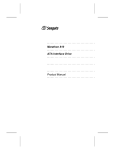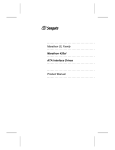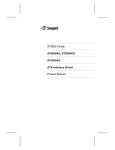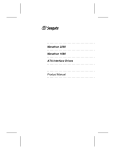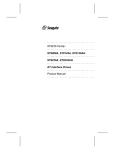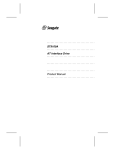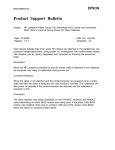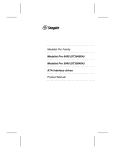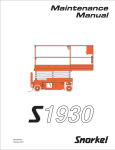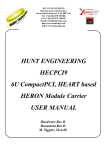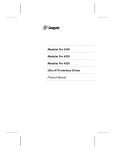Download Seagate ST9100AG Product manual
Transcript
..................................... ST9190 Family: ..................................... ST9190AG ..................................... ST9140AG ..................................... AT Interface Drives ..................................... Product Manual ..................................... ..................................... ST9190 Family: ..................................... ST9190AG ..................................... ST9140AG ..................................... AT Interface Drives ..................................... Product Manual ..................................... 1994 Seagate Technology, Inc. All rights reserved Publication Number: 36230-001, Rev. B July 1994 Seagate®, Seagate Technology® and the Seagate logo are registered trademarks of Seagate Technology, Inc. Other product names are registered trademarks or trademarks of their owners. Seagate reserves the right to change, without notice, product offerings or specifications. No part of this publication may be reproduced in any form without written permission from Seagate Technology, Inc. ST9190 Family Product Manual, Rev. B iii Contents 1.0 Drive specifications . . . . . . . . . . . . . . . . . . . . . . 1 1.1 Formatted capacity . . . . . . . . . . . . . . . . . . . . . 1 1.2 Physical organization . . . . . . . . . . . . . . . . . . . . 1 1.3 Logical organization . . . . . . . . . . . . . . . . . . . . . 1 1.4 Default logical geometry . . . . . . . . . . . . . . . . . . . 1 1.5 Functional specifications . . . . . . . . . . . . . . . . . . 2 1.6 Physical dimensions . . . . . . . . . . . . . . . . . . . . . 2 1.7 Seek time . . . . . . . . . . . . . . . . . . . . . . . . . . 2 1.8 Spinup time . . . . . . . . . . . . . . . . . . . . . . . . . 3 1.9 Reliability . . . . . . . . . . . . . . . . . . . . . . . . . . 3 1.10 Environment . . . . . . . . . . . . . . . . . . . . . . . . 4 1.10.1 Acoustics . . . . . . . . . . . . . . . . . . . . . . . 4 1.10.2 Ambient temperature . . . . . . . . . . . . . . . . . 4 1.10.3 Temperature gradient . . . . . . . . . . . . . . . . . 4 1.10.4 Relative humidity . . . . . . . . . . . . . . . . . . . 4 1.10.5 Altitude . . . . . . . . . . . . . . . . . . . . . . . . 4 1.10.6 Shock . . . . . . . . . . . . . . . . . . . . . . . . . 5 1.10.7 Vibration . . . . . . . . . . . . . . . . . . . . . . . . 5 1.11 Power specifications . . . . . . . . . . . . . . . . . . . . 6 1.11.1 Power-management modes . . . . . . . . . . . . . . 6 1.11.2 Power consumption . . . . . . . . . . . . . . . . . . 8 1.11.3 Conducted Noise . . . . . . . . . . . . . . . . . . . 9 1.12 UL/CSA listing . . . . . . . . . . . . . . . . . . . . . . . 9 1.13 FCC verification . . . . . . . . . . . . . . . . . . . . . . 9 2.0 Drive mounting and configuration . . . . . . . . . . . . . . 11 2.1 Handling and static-discharge precautions . . . . . . . . . 11 2.2 Mounting the ST9190 family drives . . . . . . . . . . . . . 11 2.3 Master/slave configuration . . . . . . . . . . . . . . . . . . 13 iv ST9190 Family Product Manual, Rev. B 2.4 Remote LED . . . . . . . . . . . . . . . . . . . . . . . . . 15 2.5 ECC testing . . . . . . . . . . . . . . . . . . . . . . . . . 15 3.0 ATA interface . . . . . . . . . . . . . . . . . . . . . . . . . 17 3.1 ATA interface connector . . . . . . . . . . . . . . . . . . . 17 3.2 ATA interface signals and connector pins . . . . . . . . . . 18 3.2.1 AT bus signal levels . . . . . . . . . . . . . . . . . . 19 3.3 ATA interface commands . . . . . . . . . . . . . . . . . . 20 3.3.1 Identify Drive command . . . . . . . . . . . . . . . . 22 3.3.2 Set Features command . . . . . . . . . . . . . . . . . 25 ST9190 Family Product Manual, Rev. B v Figures Figure 1. Typical current profile for the ST9190 family drives . . . . 8 Figure 2. Mounting dimensions for the ST9190 family drives . . . . 12 Figure 3. Connector setup for the ST9190 family drives . . . . . . 14 Figure 4. ATA interface connector for the ST9190 family drives . . 17 ST9190 Family Product Manual, Rev. B 1 1.0 Drive specifications 1.1 Formatted capacity ST9190AG ST9140AG Guaranteed Mbytes (1 Mbyte = 106 bytes) 171.6 127.9 Guaranteed sectors 335,232 249,900 Bytes per sector 512 512 1.2 Physical organization ST9190AG ST9140AG Read/Write heads 4 4 Discs 2 2 1.3 Logical organization The ST9190 family drives support all head, cylinder and sector geometries, subject to the maximums specified below, and to the following condition: (sectors) × (heads) × (cylinders) ≤ total sectors per drive ST9190AG ST9140AG Sectors per track (max) 64 64 Read/Write heads (max) 16 16 Cylinders (max) 1,024 1,024 1.4 Default logical geometry ST9190AG ST9140AG Sectors per track 24 17 Read/Write heads 16 15 Cylinders 873 980 2 ST9190 Family Product Manual, Rev. B 1.5 Functional specifications Interface AT Recording method RLL (1,7) Recording density (BPI) 57,120 Flux density (FCI) 42,840 Track density (TPI) 2,760 Spindle speed (RPM) ( ± 0.5%) 3,546 Internal data transfer rate (Mbits per sec max—ZBR) 22.13 I/O data transfer rate (Mbytes per sec max) 5.2 Interleave 1:1 Cache buffer (Kbytes) 120 1.6 Physical dimensions ST9190AG ST9140AG Height (max) inches (mm) 0.504 (12.80) 0.504 (12.80) Width (max) inches (mm) 2.760 (70.10) 2.760 (70.10) Depth (max) inches* (mm) 4.010 (101.85) 4.010 (101.85) Weight (typical) ounces (kg) 5.7 (0.161) 5.7 (0.161) * Excludes I/O connector pins, which may extend up to 0.010 inches beyond the edge of the head/disc assembly. 1.7 Seek time All seek times are measured using a 25-MHz 486 AT computer (or faster) with a 8.3-MHz I/O bus. The measurements are taken with nominal power at sea level and 25°C ambient temperature. The specifications in the table on page 3 are defined as follows: ST9190 Family Product Manual, Rev. B 3 • Track-to-track seek time is an average of all possible single-track seeks in both directions. • Average seek time is a true statistical random average of at least 5,000 measurements of seeks between random tracks, less overhead. • Full-stroke seek time is one-half the time needed to seek from the first data cylinder to the maximum data cylinder and back to the first data cylinder. The full-stroke average is determined by measuring 100 full-stroke seeks in both directions. Seek type Typical read (msec) Typical write (msec) Track-to-track 6 7 Average 16 20 Full-stroke 26 28 Average latency: 8.46 msec 1.8 Spinup time Power-on to Ready (sec) 5* typical Standby to Ready (sec) 3 typical * The drive will respond to selection and status commands within 2 seconds after power-up. 1.9 Reliability Nonrecoverable read errors 1 per 1013 bits read Mean time between failures 300,000 power-on hours (nominal power, at sea level, 25°C ambient temperature) Preventive maintenance None required Mean time to repair 10 minutes Service life 5 years 1.10 Environment 1.10.1 Acoustics Drive acoustics are measured as sound pressure 1 meter from the drive. 4 ST9190 Family Product Manual, Rev. B Idle Mode (dBA, maximum) 30 Seek (dBA, maximum) 30 1.10.2 Ambient temperature Operating 5° to 55°C (41° to 131°F) Nonoperating –40° to 70°C (–40° to 158°F) 1.10.3 Temperature gradient Operating 30°C/hr (54°F/hr) max, without condensation Nonoperating 30°C/hr (54°F/hr) max, without condensation 1.10.4 Relative humidity Operating 8% to 80% noncondensing (10% per hour max) Max. wet bulb temperature: 29.4°C (85°F) Nonoperating 8% to 90% noncondensing (10% per hour max) Max. wet bulb temperature: 40°C (104°F) 1.10.5 Altitude Operating –1,000 ft to 10,000 ft (–304 m to 3,048 m) Nonoperating –1,000 ft to 40,000 ft (–304 m to 12,192 m) ST9190 Family Product Manual, Rev. B 5 1.10.6 Shock All shock specifications assume that the drive is mounted in an approved orientation with the input levels at the drive mounting screws. The nonoperating specifications assume that the read/write heads are positioned in the shipping zone. Note. At power-down, the read/write heads automatically move to the shipping zone. The head and slider assembly park inside of the maximum data cylinder. When power is applied, the heads recalibrate to Track 0. 1.10.6.1 Operating shock The ST9190 family drives, which incorporate SafeRite components, can withstand a maximum operating shock of 100 Gs without nonrecoverable data errors (based on half-sine shock pulses of 2 and 4 msec). 1.10.6.2 Nonoperating shock The maximum nonoperating shock that the ST9190 family drives can experience without incurring physical damage or degradation in performance when subsequently put into operation is 150 Gs (based on half-sine shock pulses of 2 and 11 msec). 1.10.7 Vibration All vibration specifications assume that the drive is mounted in an approved orientation with the input levels at the drive mounting screws. The nonoperating specifications assume that the read/write heads are positioned in the shipping zone. 1.10.7.1 Operating vibration The following table lists the maximum vibration levels that ST9190 family drives may experience without incurring physical damage or degradation in performance. 5–22 Hz 0.020-inch displacement (double amplitude) 22–450 Hz 0.5 Gs acceleration (peak) 450–22 Hz 0.5 Gs acceleration (peak) 22–5 Hz 0.020-inch displacement (double amplitude) 6 ST9190 Family Product Manual, Rev. B 1.10.7.2 Nonoperating vibration The following table lists the maximum nonoperating vibration that ST9190 family drives may experience without incurring physical damage or degradation in performance when the drive is put into operation. 5–22 Hz 0.162-inch displacement (double amplitude) 22–450 Hz 4 Gs acceleration (peak) 450–22 Hz 4 Gs acceleration (peak) 22–5 Hz 0.162-inch displacement (double amplitude) 1.11 Power specifications ST9190 family drives receive DC power (+5V) through pin 41 and pin 42 of the AT interface connector. 1.11.1 Power-management modes Power management is required for low-power and portable computer systems. In most systems, you can control power management through the system setup program. The ST9190 family drives feature several power-management modes, which are described briefly below: Active mode. The drive is in Active mode during the read/write and seek operations. Idle mode. At power-on, the drive sets the idle timer to enter Idle mode after 5 seconds of inactivity. You can set the idle timer delay using the system setup utility. In Idle mode, the spindle remains up to speed. The heads are parked away from the data zones for maximum data safety. The buffer remains enabled, and the drive accepts all commands and returns to Active mode any time disc access is necessary. Standby mode. The drive enters Standby mode when the host sends a Standby Immediate command. If the standby timer has been set by the host system, the drive can also enter Standby mode automatically after the drive has been inactive for a specifiable length of time. The standby timer delay is system-dependent and is usually established using the system setup utility. In Standby mode, the buffer remains enabled, the heads are parked and the spindle is at rest. The drive accepts all commands and returns to Active mode any time disc access is necessary. Sleep mode. The drive enters Sleep mode after receiving a Sleep Immediate command from the host. The heads are parked and the spindle is at rest. The drive leaves Sleep mode when a Hard Reset or ST9190 Family Product Manual, Rev. B 7 Soft Reset command is received from the host. After receiving a soft reset, the drive exits Sleep mode and enters Standby mode with all current emulation and translation parameters intact. Idle and standby timers. The drive sets the default time delay for the idle timer at power-on. In most systems, you can set this delay using the system setup utility. Each time the drive performs an Active function (read, write or seek), the idle and standby timers are reinitialized and begin counting down from their specified delay times to zero. If the idle timer reaches zero before any drive activity is required, the drive makes a transition to Idle mode. If the host has set the standby timer, the standby countdown continues. If the host has not set the standby timer, the drive remains in Idle mode. If the standby timer reaches zero before any drive activity is required, the drive makes a transition to Standby mode. In both Idle and Standby mode, the drive accepts all commands and returns to Active mode when disc access is necessary. Deferred spinup. ST9190 family drives may be factory-configured for deferred spinup. If configured for deferred spinup, the drive does not spin up immediately after power-on, but waits until a command is received from the host. At power-on, the drive posts a status of 80H and all master/slave protocols are completed before the drive reports a status of 50H. After the drive receives a command from the host, it executes the normal spinup/upload process. If the host issues a soft reset prior to drive spinup, the drive responds normally, except that it does not spin up until it receives a command from the host. 8 ST9190 Family Product Manual, Rev. B 1.11.2 Power consumption Power requirements for the ST9190 family drives are listed in the table below. Typical power measurements are based on an average of drives tested under nominal conditions, using 5.0V input voltage at 25°C ambient temperature at sea level. Active mode current and power are measured with two spindle rotations between each operation and the drive in default logical geometry. Startup power is measured from the time the drive is powered on to the time the drive is ready for normal operation. Seeking power and currents are measured during one-third-stroke buffered seeks. Read/Write power and current are measured with the heads on track. Mode Typical watts RMS Typical amps RMS (at nominal voltage) (at nominal voltage) Startup 3.000 0.600 1.650 1.600 0.330 0.320 Idle 0.700 0.140 Standby 0.155 0.031 Sleep 0.085 0.017 Active: Seek Read/Write 1.11.2.1 Typical current profile A typical startup and current profile for an ST9190 family drive is shown in Figure 1. Current (mA) 1000 Spinup 900 Drive Ready 800 Idle mode Standby mode 700 600 Active mode Sleep mode 500 Upload code 400 300 200 100 0 0 1 2 3 4 5 6 7 8 Time (seconds) 9 10 11 12 Figure 1. Typical current profile for the ST9190 family drives 13 14 ST9190 Family Product Manual, Rev. B 9 1.11.3 Conducted Noise The drive will operate with a maximum permitted conducted noise of: • 150 mV peak-to-peak triangular wave injected noise at the power connector. The frequency is 10 Hz to 100 KHz with equivalent resistive loads. • 100 mV peak-to-peak triangular wave injected noise at the power connector. The frequency is 100 KHz to 10 MHz with equivalent resistive loads. Note. Equivalent resistance is calculated by dividing the respective voltage by the typical RMS read/write current. Voltage tolerance (including noise): +5V +5%, –10% 1.12 UL/CSA listing The ST9190 family drives are listed in accordance with UL 1950 and CSA C22.2 (950-M89) and meet all applicable sections of IEC 380, IEC 435, IEC 950, VDE 0806/08.81 and EN 60950 as tested by TUV-Rheinland, North America. 1.13 FCC verification The ST9190 family drives are intended to be contained solely within a personal computer or similar enclosure (not attached to an external device). As such, each drive is considered to be a subassembly even when it is individually marketed to the customer. As a subassembly, no Federal Communications Commission verification or certification of the device is required. Seagate Technology, Inc. has tested this device in enclosures as described above to ensure that the total assembly (enclosure, disc drive, motherboard, power supply, etc.) does comply with the limits for a Class B computing device, pursuant to Subpart J, Part 15 of the FCC rules. Operation with noncertified assemblies is likely to result in interference to radio and television reception. Radio and Television Interference. This equipment generates and uses radio frequency energy and if not installed and used in strict accordance with the manufacturer’s instructions, may cause interference to radio and television reception. 10 ST9190 Family Product Manual, Rev. B This equipment is designed to provide reasonable protection against such interference in a residential installation. However, there is no guarantee that interference will not occur in a particular installation. If this equipment does cause interference to radio or television, which can be determined by turning the equipment on and off, you are encouraged to try one or more of the following corrective measures: • Reorient the receiving antenna. • Move the device to one side or the other of the radio or TV. • Move the device farther away from the radio or TV. • Plug the computer into a different outlet so that the receiver and computer are on different branch outlets. If necessary you should consult your dealer or an experienced radio/television technician for additional suggestions. You may find helpful the following booklet prepared by the Federal Communications Commission: How to Identify and Resolve Radio-Television Interference Problems. This booklet is available from the Superintendent of Documents, U.S. Government Printing Office, Washington, DC 20402. Refer to publication number 004-000-00345-4. ST9190 Family Product Manual, Rev. B 11 2.0 Drive mounting and configuration 2.1 Handling and static-discharge precautions After unpacking, and prior to installation, the drive may be exposed to potential handling and ESD hazards. Observe standard static-discharge precautions. A grounded wrist-strap is preferred. Handle the drive only by the sides of the head/disc assembly. Avoid contact with the printed circuit board, all electronic components and the interface connector. Do not apply pressure to the top cover. Always rest the drive on a padded antistatic surface until you mount it in the host system. 2.2 Mounting the ST9190 family drives You can mount ST9190 family drives in any orientation. Allow a minimum clearance of 0.030 inches (0.76 mm) around the entire perimeter of the drive for cooling. Figure 2 on page 12 provides mounting dimensions for the ST9190 family drives. These drives conform to the industry-standard MCC directmounting specifications and require the use of MCC-compatible connectors in direct-mounting applications. Note. The I/O connector pins may extend up to 0.010 inches beyond the edge of the head/disc assembly. Caution. To avoid damaging the drive: • Use M3X0.5 metric mounting screws only. • Do not insert mounting screws more than 0.150 inches (3.81 mm) into the mounting holes. • Do not overtighten the screws (maximum torque: 3 inch-lb). 12 ST9190 Family Product Manual, Rev. B Dimensions are in inches (mm) 0.489 ± 0.015 (12.42 ± 0.38) 4.010 (101.85) max. (head/disc assembly) 0.118 ± 0.010 (3.00 ± 0.25) 0.000 in (mm) 4X 3 mm × 0.5 mm, 0.15 in (3.81mm) min. full thread 0.152 ± 0.005 (3.86 ± 0.13) 1.227 ± 0.020 (31.17 ± 0.51) 4.020 (102.11) max. (head/disc assembly to tip of pins) 1.500 ± 0.010 (38.10 ± 0.25) 0.000 1.375 ± 0.015 (34.93 ± 0.38) 0.155 ± 0.020 (3.94 ± 0.51) 0.000 0.239 ± 0.035 (6.07 ± 0.89) 2.740 ± 0.020 (69.60 ± 0.51) 2.430 ± 0.010 (61.72 ± 0.25) 4X 3 mm × 0.5 mm, 0.15 in (3.81 mm) min. full thread Pin 1 0.157 ± 0.010 (3.99 ± 0.25) 0.079 (2.00) 0.079 (2.00) Pin 20 removed for keying Figure 2. Mounting dimensions for the ST9190 family drives ST9190 Family Product Manual, Rev. B 13 2.3 Master/slave configuration A master/slave relationship must be established between multiple drives attached to a single AT bus. You can configure a drive to become a master or slave by setting the master/slave jumpers as described below and shown in Figure 3 on page 14. If only one jumper is installed or if neither jumper is installed, then the jumper settings on each drive determine whether that drive is a master or a slave. Alternatively, you can configure an ST9190 family drive as a master or slave using the cable select option. This requires a specialized daisychain cable that grounds pin 28 (CSEL) on one of its two drive connectors. If you attach the drive to the grounded CSEL connector, it becomes a master. If you attach the drive to the ungrounded CSEL connector, it becomes a slave. To use this option, the host system and both drives must support cable select. To configure an ST9190 family drive for cable select, install both master/slave jumpers. Regardless of which jumper settings are used, the slave drive must assert the DASP– signal at power up and the master drive must monitor DASP– at power up for the slave to be recognized. Jumper for pins A and B Jumper for pins C and D Removed Removed Drive is master; slave drive may be detected using DASP– signal. CSEL is ignored. Removed Installed Drive is master; slave drive is present. CSEL is ignored. Installed Removed Drive is slave (a master drive should be present also). CSEL is ignored. Installed Installed Differentiate master and slave drives using cable select. If a drive is attached to a connector in which pin 28 is grounded, it becomes a master. If a drive is attached to a connector in which pin 28 is ungrounded, it becomes a slave. Configuration 14 ST9190 Family Product Manual, Rev. B Master/slave configuration jumpers Pin 1 B A Pin 20 removed for keying Circuit board D C Drive is master; slave may be detected using DASP– signal Drive is master; Seagate slave drive present Drive is slave; Seagate master drive present Use CSEL pin grounding to differentiate master from slave Figure 3. Connector setup for the ST9190 family drives ST9190 Family Product Manual, Rev. B 15 2.4 Remote LED The drive indicates activity to the host through the DASP– line (pin 39) on the ATA interface. This line may be connected to a drive status indicator driving an LED at 5V. The line has a 30 mA nominal current limit. Note. If the drive is configured to use the DASP– signal to determine master/slave configuration, this signal is shared with the LED. In this configuration, DASP– signals will be visible as LED flashes. 2.5 ECC testing When an ST9190 family drive performs hardware-based ECC error correction on-the-fly, the drive does not report an ECC error. This allows ECC correction without degrading drive performance. Some older drive diagnostic programs test ECC features by creating small data errors and then checking to see if they are reported. Such tests, when run on an ST9190 family drive, may incorrectly report an ECC-detection failure because the drive hardware corrects the data automatically, avoiding the error rather than reporting it. Such a report does not indicate a drive malfunction. ST9190 Family Product Manual, Rev. B 17 3.0 ATA interface The ST9190 family drives use the industry-standard ATA task file interface. The drives support both 8-bit and 16-bit data transfers. They support ATA programmed input/output (PIO) modes 0 and 1, but do not support DMA data transfers. The drives can differentiate between a hard reset and a soft reset while in Sleep mode. You can connect up to two drives on the same AT host bus. For detailed information regarding Seagate’s implementation of the ATA interface, see the Seagate ATA Interface Reference Manual. 3.1 ATA interface connector The drive connector is a 44-conductor connector with 2 rows of 22 male pins on 0.079-inch (2 mm) centers (see Figure 4). The mating cable connector is a 44-conductor, nonshielded connector with 2 rows of 22 female contacts on 0.079-inch (2 mm) centers. The connectors should provide strain relief and should be keyed with a plug in place of pin 20. The ST9190 family drives are designed to support the industry standard MCC direct-mounting specifications. When installing these drives in fixed mounting applications, use only MCC-compatible connectors such as Molex part number 87368-442x. For applications involving flexible cables or printed circuit cables (PCCs), use Molex part number 87259-4413 or equivalent to connect the drive to the system. For applications that require the use of the master/slave configuration jumpers, select a connector that provides adequate clearance for the jumpers. The ATA interface cable should be no more than 18 inches long. Dimensions are in inches (mm) Master/slave jumpers 0.079 ± 0.003 (2.00 ± 0.08) 0.020 ± 0.002 (0.51 ± 0.05) 1.654 (42.01) 0.152 ± 0.005 (3.71 ± 0.20) 0.020 ± 0.002 (0.51 ± 0.05) 0.079 ± 0.003 (2.00 ± 0.08) 0.158 ± 0.003 (4.00 ± 0.08) Figure 4. ATA interface connector for the ST9190 family drives Note. The I/O connector pins may extend up to 0.010 inches beyond the edge of the head/disc assembly. 18 ST9190 Family Product Manual, Rev. B 3.2 ATA interface signals and connector pins The following diagram summarizes the signals on the ATA interface connector that are supported by the ST9190 family drives. For a detailed description of these signals, refer to the Seagate ATA Interface Reference Manual. Drive pin # 1 2 3 4 5 6 7 8 9 10 11 12 13 14 15 16 17 18 19 20 21 22 23 24 25 26 27 28 29 30 31 32 33 34 35 36 37 38 39 40 41 42 43 44 Signal name Reset– Ground DD7 DD8 DD6 DD9 DD5 DD10 DD4 DD11 DD3 DD12 DD2 DD13 DD1 DD14 DD0 DD15 Ground (removed) Reserved Ground DIOW– Ground DIOR– Ground Reserved CSEL Reserved Ground INTRQ IOCS16– DA1 PDIAG– DA0 DA2 CS1FX– CS3FX– DASP– Ground Power Power Ground Reserved Host pin # and signal description 1 2 3 4 5 6 7 8 9 10 11 12 13 14 15 16 17 18 19 20 21 22 23 24 25 26 27 28 29 30 31 32 33 34 35 36 37 38 39 40 41 42 43 44 Host Reset Ground Host Data Bus Bit 7 Host Data Bus Bit 8 Host Data Bus Bit 6 Host Data Bus Bit 9 Host Data Bus Bit 5 Host Data Bus Bit 10 Host Data Bus Bit 4 Host Data Bus Bit 11 Host Data Bus Bit 3 Host Data Bus Bit 12 Host Data Bus Bit 2 Host Data Bus Bit 13 Host Data Bus Bit 1 Host Data Bus Bit 14 Host Data Bus Bit 0 Host Data Bus Bit 15 Ground (No Pin) Reserved Ground Host I/O Write Ground Host I/O Read Ground Reserved Cable Select Reserved Ground Host Interrupt Request Host 16 Bit I/O Host Address Bus Bit 1 Passed Diagnostics Host Address Bus Bit 0 Host Address Bus Bit 2 Host Chip Select 0 Host Chip Select 1 Drive Active/Slave Present Ground +5 volts DC (logic) +5 volts DC (motor) Ground for power pins Reserved Pins 28, 34 and 39 are used for master-slave communication (details shown below). Drive 1 (slave) 28 34 39 Drive 0 (master) 28 34 39 CSEL PDIAG– DASP– Host 28 34 39 ST9190 Family Product Manual, Rev. B 3.2.1 19 AT bus signal levels Signals that the drive sends have the following output characteristics at the drive connector: Logic low 0.0V to 0.4V Logic high 2.5V to 5.25V Signals that the drive receives must have the following input characteristics, measured at the drive connector: Logic low 0.0V to 0.8V Logic high 2.0V to 5.25V 20 ST9190 Family Product Manual, Rev. B 3.3 ATA interface commands The following table lists ATA-standard and Seagate-specific drive commands that are supported by the ST9190 family drives. For a detailed description of these commands, refer to the Seagate ATA Interface Reference Manual. Command name Command Supported by code ST9190 family drives ATA-standard commands Execute Drive Diagnostics 90H Yes Format Track 50H Yes Identify Drive ECH Yes Initialize Drive Parameters 91H Yes NOP 00H No Read Buffer E4H Yes Read DMA (w/retry) C8H No Read DMA (no retry) C9H No Read Long (w/retry) 22H Yes Read Long (no retry) 23H Yes Read Multiple C4H No Read Sectors (w/retry) 20H Yes Read Sectors (no retry) 21H Yes Read Verify Sectors (w/retry) 40H Yes Read Verify Sectors (no retry) 41H Yes Recalibrate 1xH Yes Seek 7xH Yes Set Features EFH Yes Set Multiple Mode C6H No Write Buffer E8H Yes Write DMA (w/retry) CAH No ST9190 Family Product Manual, Rev. B Command name 21 Command Supported by code ST9190 family drives Write DMA (no retry) CBH No Write Long (w/retry) 32H Yes Write Long (no retry) 33H Yes Write Multiple C5H No Write Same E9H No Write Sectors (w/retry) 30H Yes Write Sectors (no retry) 31H Yes Write Verify 3CH No ATA-standard power management commands Check Power Mode 98H or E5H Yes Idle 97H or E3H Yes Idle Immediate 95H or E1H Yes Sleep 99H or E6H Yes Standby 96H or E2H Yes Standby Immediate 94H or E0H Yes Seagate-specific power management commands Active and Set Idle Timer FBH Yes Active Immediate F9H Yes Check Idle Mode FDH Yes Idle Immediate F8H Yes Idle and Set Idle Timer FAH Yes 22 ST9190 Family Product Manual, Rev. B The following commands are specific to the ST9190 family drives or contain drive-specific features. 3.3.1 Identify Drive command The Identify Drive command (command code ECH) transfers information about the drive to the host after power up. The data is organized as a single 512-byte block of data, whose contents are shown in the table below. All reserved bits or words should be set to zero. Parameters listed with an “x” are drive specific or vary with the state of the drive. See Section 1 of this manual for default parameter settings for the ST9190 family drives. Word Description 0 Configuration information: Bit 10: disc transfer > 10 Mbits/sec Bit 6: fixed drive Bit 4: head switch time > 15 µsec Bit 3: not MFM encoded Bit 1: hard sectored disc 045AH 045AH 1 Number of fixed cylinders (default logical emulation) 0369H 03D4H 2 ATA reserved 0000H 0000H 3 Number of heads (default) 0010H 000FH 4 Number of unformatted bytes per track 8D90H 8D90H 5 Number of unformatted bytes per sector 0248H 0248H 6 Number of sectors per track (default logical emulation) 0018H 0011H ATA reserved 0000H 0000H Serial Number: (20 ASCII characters, 0000H = none) ASCII ASCII 20 Controller type = dual-ported multisector buffer with caching 0003H 0003H 21 Buffer size (number of 512-byte sectors) 00F0H 00F0H 7–9 10–19 ST9190AG ST9140AG ST9190 Family Product Manual, Rev. B Word 22 Description Number of ECC bytes available (16) Firmware revision (8 ASCII 23–26 character string): xx = ROM version, ss.tt = RAM version 27–46 23 ST9190AG ST9140AG 0010H 0010H xx.ss.tt xx.ss.tt ST9190AG ST9140AG Drive model number: (40 ASCII characters, padded to end of string) 47 Maximum sectors per interrupt on read/write multiple 0000H 0000H 48 Double word I/O (not supported) 0000H 0000H 49 DMA data transfer and IORDY (supported) 0000H 0000H 50 ATA reserved 0000H 0000H 51 PIO data transfer cycle timing mode 0000H 0000H 52 DMA transfer cycle timing mode 0000H 0000H 53 Validity of words 54–58 and words 64–70 (1 indicates words 54–58 may be valid) 0001H 0001H 54 Number of cylinders (current emulation mode) xxxxH xxxxH 55 Number of heads (current emulation mode) xxxxH xxxxH 56 Number of sectors per track (current emulation mode) xxxxH xxxxH 57–58 Number of sectors (current emulation mode) xxxxH xxxxH 59 Read Multiple/Write Multiple setting (not supported). 0000H 0000H 0000H 0000H 0000H 0000H 60–61 ATA reserved 62 continued Single-word DMA settings (DMA not supported) 24 ST9190 Family Product Manual, Rev. B continued from previous page Word Description ST9190AG ST9140AG 63 Multiword DMA settings (DMA not supported) 0000H 0000H 64 Advanced PIO mode settings (not supported) 0000H 0000H 65 Minimum multiword DMA transfer cycle time per word (not supported) 0000H 0000H 66 Recommended multiword DMA transfer cycle time per word (not supported) 0000H 0000H 67 Minimum PIO cycle time without IORDY flow control (not supported) 0000H 0000H 68 Minimum PIO cycle time with IORDY flow control (not supported) 0000H 0000H 0000H 0000H 128–159 Seagate reserved xxxxH xxxxH 160–255 ATA reserved 0000H 0000H 69-127 ATA reserved ST9190 Family Product Manual, Rev. B 3.3.2 25 Set Features command This command controls the implementation of various features supported by the drive. When the drive receives this command, it sets BSY, checks the contents of the Features register, clears BSY and generates an interrupt. If the value in the register does not represent a feature supported by the drive, the command is aborted. Power-on default has the read look-ahead and write caching features enabled and 4 bytes of ECC. The acceptable values for the Features register are defined as follows: 02H Enable write cache (default) 44H 16 bytes of ECC apply on read long and write long commands 55H Disable read look-ahead (read cache) feature 66H Disable reverting to power-on defaults 82H Disable write cache AAH Enable read look-ahead (read cache) feature (default) BBH 4 bytes of ECC apply on read long and write long commands (default) CCH Enable reverting to power-on defaults (default) At power-on, or after a hardware reset, the default values of the features are as indicated above. A software reset also changes the features to default values unless a 66H command has been received. Seagate Technology, Inc. 920 Disc Drive, Scotts Valley, California 95066, USA Publication Number: 36230-001, Rev. B, Printed in USA




































